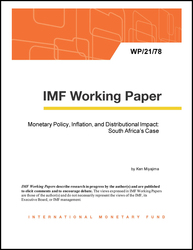
Monetary Policy, Inflation, and Distributional Impact: South Africa’s Case
Monetary Policy, Inflation, and Distributional Impact: South Africa’s Case
READ MORE...
Volume/Issue:
Volume 2021
Issue 078
Publication date: March 2021
ISBN: 9781513574356
$18.00
Add to Cart by clicking price of the language and format you'd like to purchase
Available Languages and Formats
| English |
Prices in red indicate formats that are not yet available but are forthcoming.
Topics covered in this book
This title contains information about the following subjects.
Click on a subject if you would like to see other titles with the same subjects.
Banks and Banking , Inflation , Economics- Macroeconomics , Economics / General , International - Economics , Distributional effects , inflation , monetary policy , South Africa , , South Africa , consumption decile , monetary policy shock , index data , food consumption , consumption ratio , Consumption , Household consumption , Central bank policy rate , Income inequality , Africa
Summary
The South African Reserve Bank has continued to fulfill its constitutional mandate to protect the value of the local currency by keeping inflation low and steady. This paper provides evidence that monetary policy tightening aimed at maintaining low and stable inflation could at the same time reduce consumption inequality over a 12–18 month horizon, commonly understood as the transmission lag of monetary policy action to the real economy, and similar to the distance between survey waves used in the analysis. In response to “exogenous” monetary policy tightening, the real consumption of individuals at lower ends of the consumption distribution declines relatively modestly, or even increases. With greater reliance on government transfers, thus smaller reliance on labor income, and relatively larger food consumption, these individuals appear to benefit mainly from lower inflation. By contrast, the real consumption of individuals at higher ends of the consumption distribution is more likely to decline due to lower labor income, weaker asset price performance, and higher debt service cost.
Copyright © 2010 - 2024
Powered by:
AIDC



